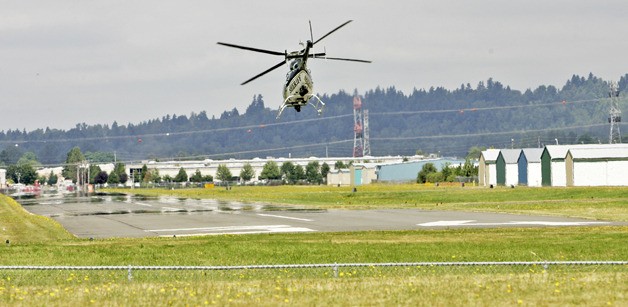It’s a low rumbling, an eerie rattle that rapidly intensifies, as if danger looms. Continuous for seconds, minutes at a time, it carries an alarmingly powerful resonance, a jolt for anyone below.
Helicopters have flown over Auburn since the municipal airport’s construction in 1969. Neighborhoods near the airport have become accustomed to air traffic, a by-product of close proximity to a runway. But it wasn’t until recently that noise from helicopters became a concern.
“In the early 1990s I didn’t notice them at all,” said Mark Hovind, a longtime Auburn resident. “Maybe a stray one coming over now and then, but there was no traffic pattern of every five minutes going over and over and over.”
Greg Brown, principal of North Auburn’s Dick Scobee Elementary, has suffered the noise of low-flying helicopters over his school. The noise staggers teachers and students, whether the windows are open or closed in the classrooms.
“Depending on how low they fly, sometimes, it literally shook the windows,” Brown said. “On occasion, the teachers do have to stop and let the helicopter pass before they can continue teaching.”
Though only two helicopters operate out of the Auburn Airport, many more fly over the valley. Based elsewhere in the area, some pilots fly here to use the open space, airport operations manager Mike Shipman said. Jamelle Garcia of the Airport Management Group, LLC has watched the shift in flight patterns over the years.
“As Tukwila built up and Kent built up, the helicopters have moved farther south to find more open space, and we happen to be the next town,” Garcia said. “It’s just transitioned.”
In May 2009, the City proposed an ordinance labeling low-flying aircraft a public nuisance and regulating an altitude of 1,000 feet above the highest obstacle within 2,000 feet of the aircraft. The Federal Aviation Administration, a branch of the federal government, shot down the ordinance in October 2009, citing federal preemption. The ordinance conflicted with federal regulations governing aviation, and because the laws of the U.S. government reign supreme, the federal regulations won out.
Frustrated with the nuisance, Hovind contacted the City and the airport to complain.
“People were voicing complaints,” said Hovind’s wife, Cheryl. “But no one knew how to handle it or step forward or do anything to try to fix it.”
After apologetic yet static responses, Hovind created a Web site to document the helicopters’ flight patterns and communications he received from the City, the FAA and the airport. Hidden online, the site doesn’t show up in search engines, and users must know the unorthodox URL to access the information.
A picture of a crashed helicopter adorns the home page, with the caption “One of these days … at a school, or in your backyard, or somewhere nearby … this WILL happen and people WILL die. Meanwhile, you’ll watch them fly low over your house and your kid’s school, wondering why someone doesn’t change something.”
Hovind said he wanted to make sure everything posted on the site was accurate before he unleashed it online, giving people a chance to “rebut anything said.” Given the seemingly tangled web of bureaucracy, he believes this is the only solution.
Safety concerns
Others also worry about the imminence of a helicopter crash. When choppers fly over the Dick Scobee playground at recess, Brown can’t help but worry for the safety of his students. The possibility of a crash concerns Rob Swartz, who works in North Auburn and lives on the east side.
“Watching them fly over the highway,” Swartz said, “it’s like, ‘Now, I not only have to look right and left for cars, I have to look up for helicopters?’ The safety issue is a problem.”
Fatal helicopter crashes aren’t as likely as they seem. According to the National Transportation Safety Board, of the 464 helicopter accidents on record, about 13 percent have resulted in death. In fact, if something goes wrong during the flight, it’s much harder for airplanes to land safely over highly populated areas because they have to glide to a large open space. Helicopters, on the other hand, can set down vertically in a street, said FAA spokesperson Mike Fergus.
“The nature of their flying allows them to set down in any immediate, flat open area easier than a regular aircraft,” Fergus said.
Technically, helicopter pilots aren’t doing anything wrong. The Code of Federal Regulations, the United State’s administrative law, sets minimum altitudes for aircraft, but helicopters are exempt. This means that, according to federal law, helicopters can fly as low as they want.
“The City of Auburn can advocate for the City of Auburn,” said Councilman Bill Peloza. “But the bottom line is the citizen has to complain to the U.S. government.”
Though their hands are ultimately tied, the City, the pilots and the airport are all concerned about the issue. Airwork, LLC, a flight school based out of the Auburn Airport, has put mufflers on its helicopters, instituted a voluntary, company-wide minimum altitude of 800 feet and changed its flight patterns in an attempt to alleviate the noise.
“We don’t have a ton of power to deviate from those because of safety and because they’re federal regulations,” said Nick DuBay, general manager and flight instructor for the school. “We’re all working together here in Auburn.”
File complaints to FAA
Peloza advocates filing a complaint with the local FAA office, via a form on the City Web site and contacting one’s congressional representative. Without a push from residents, he said, the problem won’t be fixed.
“We want to hear from citizens,” Peloza said. “We want them to feel safe in our city. We want them to have a secure quality of life. We are attempting to provide that, but we need citizen assistance.”



